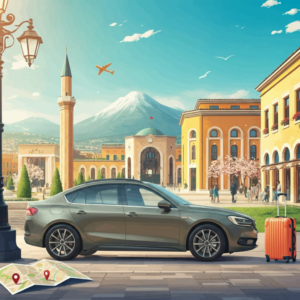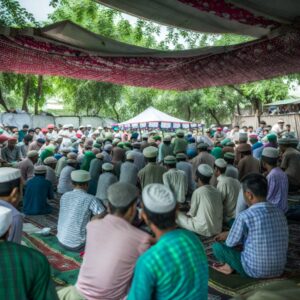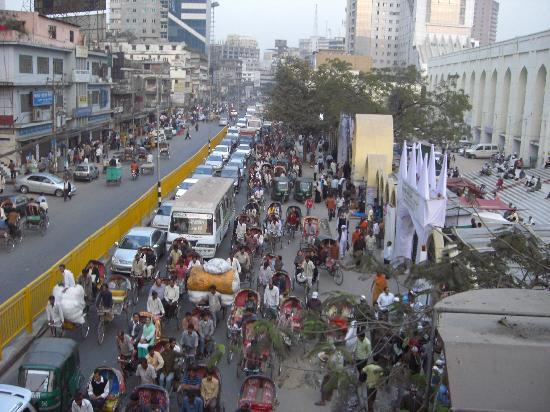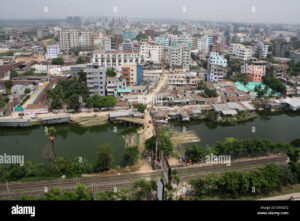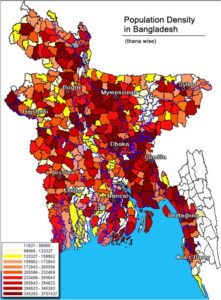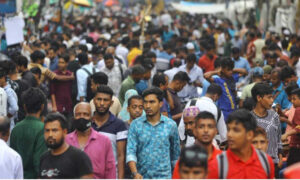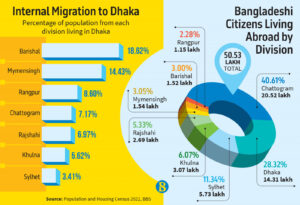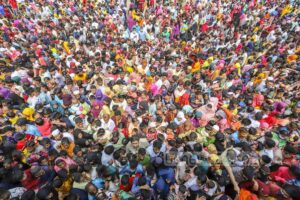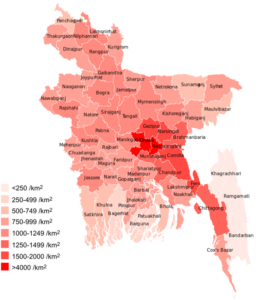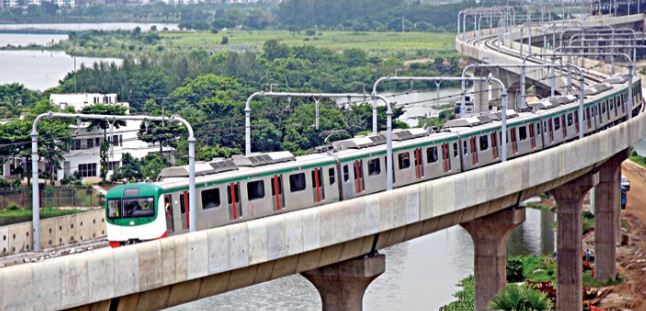Dhaka city history: Dhaka is the Capital of Bangladesh. It is said to refer the Word Dhaka came from the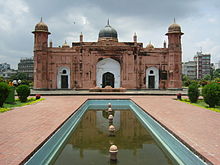
Dhaka
In 1576, The Mughal Empire took the control of this area and developed many mosques, forts, universities, etc. Subahdar Islam Khan was the first Administrator of the city who changes the city name to “Jahangir Nagar in honor of Emperor Jahangir. Jahangir Nagar was dropped soon after the death of Emperor Jahangir.
Capital city of Bangladesh
Bangladeshi Dhaka Location : North: 23°22’30” to 24°22’20” And East : 89°41’6” to 90°21’23”. It is situated almost middle of Bangladesh Dhaka City Map
Dhaka Area
- Dhaka City Area / Size : 1463.60 Sq. Km.
Population of Dhaka
- Population of Dhaka Bangladesh is 24.65 millions. (2025)
In 2017, Population of Dhaka City was about 19 Million.
The city Dhaka is the most populated city in Bangladesh. Dhaka is also one of the most populated cities in the World. In 1950, the population of Dhaka was 8.5 million but in 2013, the population of Dhaka 14.4 million. In 2017, Dhaka population is about 19 million. The city Dhaka is one the densely populated city of the world. There are 48000 people live in a square kilometer.
Male : people
Female : people
Educated : 74.60 %
Density of Dhaka City : 29069 per sq. km
Growth of Population : 3.48%
Temperature of Dhaka City: Summer 36.7° c 21.1° c , Winter 31.7° c 10.5°c
Rainfall : 2540 mm annually.
Humidity : 80 per cent (approx)
Languages : Bangla, English widely spoken and understood.
Currency: Taka (BDT)
Ethnicity: Bengali 98%, other 2% (includes tribal groups, non-Bengali Muslims)
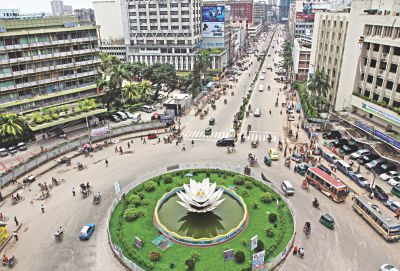
Upazila in Dhaka: 5
Metropolitan Police Station : 41
City Corporation : 2
Municipality : 3
Union Parishad : 86
Mouza : 974
Villages: 1999
Ward : 92
Parliament Seats in Dhaka City: 20
Colleges in the capital of Bangladesh : 167
High School : 479
Madrasa : 165
Government Primary School: 728
Private Primary School : 689
Mosques: 3088
Temples : 808
Churches : 33
Rivers are in the Capital of Bangladesh :
Dholeshwari ,
Buriganga,
Bongshi,
Turag,
Balunadi
Working force : 50%of the population aged 10 years and above are in gainfull employment.
*Informal Activities : 24%
* Household Work : 28%
*Other Services :25%
*Unemployed : 23%
Garments Works and Household Work (Woman) : :0.8 million.
*Per Capita Income :US$ 550
*Literacy Rate : 63.2%
Graveyard :
Banani Graveyard
Khilgaon Taltola Graveyard
Mirpur Buddijibi Kabarstand
Azimpur Graveyar
Bangladeshi Dhaka attractions
National Mosques : Baitull Mukarram
Hindu Temples: Most popular hindu temples are Dhakeshwari Temple (11th Century), Ramkrishna Mission.
Churches : Popular Churches are Armenian Church (1781 A.D.) St. Mary’s Cathedral at Ramna, Church of Bangladesh or former Holy Rosary Church (1677A.D.) at Tejgaon.
Bangabandhu Memorial Museum in Dhaka: It was the residence of Bangabandhu Sheikh Mujibur Rahman at Dhanmondi has been turned into a musuam.
Curzon Hall : Beautiful architectural building named after Lord Curzon. Science Faculty of Dhaka University at Karzon Hall.
Old High Court Building : Originally built as the residence of the British Governor, it illustrates a happy blend of European and Mughal architecture.
Dhaka Zoo : Mirpur Zoo.
Botanical Garden : Botanical Garden situated on an area of 205 acres of land at Mirpur and adjacent to Mirpur Dhaka Zoo.
National Park : Situated at Rejendrapur, 40 km. north of Dhaka city , this is a vast (1,600 acres) national recreational forest with facilities for picnic and rowing etc.
Shahid Minar
National Poet’s Graveyard : The poet Kazi Nazrul Islam died on the 29 August 1976 and was buried in the graveyard is adjacent to the Dhaka University Mosque.
Mausoleum of National Leaders : the mousoleum is located at the southwestern corner of Suhrawardy Uddyan, it is the eternal resting place of great national leaders, Sher-e-Bangla A.K. Fazlul Haque, Hossain Shahid Suhrawardy and Khaja Nazimuddin.
BangaBhaban : The official residence of the President of Bangladesh, near Motijheel area of Dhaka city.. One can have an outside view of this grand palace.
Ramna Green: A vast stretch of green garden surrounded by a serpentine lake near the Sheraton Hotel.
Parliament House : Jatiya Sangsad Bhaban (Parliament House of Bangladesh) located at Sher e Bangla Nagar has distinctive architectural features. the Assembly building was designed by the famous architect Louis I. Kahn, it may be called an architectural wonder of this region.
Science Museum : The museum is a modern learning center related to the latest scientific discoveries. Science Museum is situated at Agargaon of Dhaka.
National Memorial : It locates at Savar, 35, km. from Dhaka city. The memorial designed by architect Moinul Hossain is dedicated to the sacred memory of the millions of unknown martyrs of the war of liberation.
Sonargaon : A Folk Arts & Crafts Museum
Amusement parks in the capital of Bangladesh
Bangladeshi Dhaka is a bustling metropolis known for its rich history, culture, and rapid urbanization. Situated along the banks of the Buriganga River, Dhaka has evolved into one of the most densely populated cities in the world. With a population that exceeds 20 million, Dhaka faces numerous challenges related to congestion, pollution, and infrastructure development. Despite these hurdles, Dhaka remains the economic and cultural heart of Bangladesh, driving the nation’s progress.
The history of Bangladeshi Dhaka dates back to ancient times, with its roots deeply embedded in the Bengal Sultanate. Over the centuries, the city has experienced several transformations, influenced by various rulers, including the Mughals, who left an indelible mark on its architecture. Notable landmarks such as Lalbagh Fort and Ahsan Manzil showcase the city’s historical significance.
Today, Dhaka is known for its thriving textile industry, vibrant markets, and diverse culinary scene. Places like New Market and Sadarghat give visitors a glimpse into the chaotic yet fascinating life of the city. Despite its challenges, Dhaka continues to grow, with ongoing efforts to improve its infrastructure and quality of life for its citizens. The energy and resilience of Dhaka make it a unique and unforgettable destination in South Asia.
Nagar Bhaban in Fulbaria, Gulistan, Dhaka
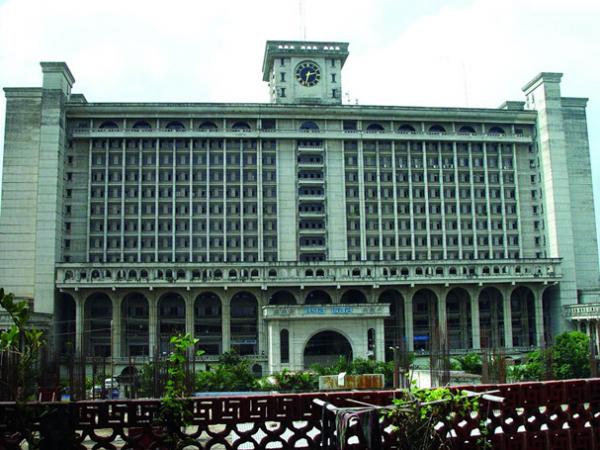
Dhaka South City Corporation
Dhaka North city Corporation
Information Bangladesh capital
| Dhaka City Established on
Name at that time Establishes under First Chairman First elected Chairman
Corporation Statute Upgraded in to City Corporation First Mayor (by Commissioners) First Elected Mayor Second Elected Mayor Number of Wards Number of Wards Commissioners Number of Elected Women Ward Commissioners Area No. of Project Total Budget of the Projects Total Budget of DCC (2003-2004)
Population in Dhaka City corporation Number of Officers/Staffs Road Drains Sewerage Footpaths Roads Media Foot over Bridges Hydraulic Ladders Wireless Set Collage Satellite School No.of UDC City Museum
|
: 1 st August 1864 .
: Dhaka Municipal Committee. : District Municipal Improvement Act, 1864. : Mr. Skinner District Magistrate : Roy Bahadur Ananda Chandra Roy (1885-1885). : Dhaka City Corporation Ordinance, 1983. : 1990. : Barrister Abul Hasant .
: Mr. Mohammad Hanif (Late) : Mr. Sadek Hossain Khoka : 92
: 360 sq.km.(Approx) : : 1318.98 crore taka : 762.9 Crore taka (estimated)
: 6 million : 11000 : 1968 km. : 2460 km : 1431 km : 163 km : 200 km. : 19 : 1 : 103 : 1 : 100 : 1 : 87
|
List of Police stations in Dhaka
- Bangshal
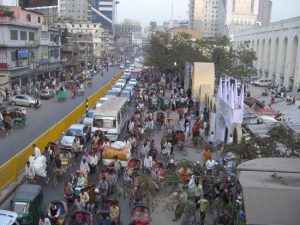
- Badda
- Cantonment
- Chackbazar
- Daskhinkhan
- Demra
- Darussalam
- Dhanmondi
- Gulshan
- Gandaria
- Hazaribag
- Jatrabari
- Kadamtoli
- Kafrul
- Khilkhet
- Kalabagan
- Kamrangirchar
- Khilgaon
- Kotwali
- Lalbag
- Mirpur
- Mohammadpur
- Motijheel
- New Market
- Paltan
- Pallabi
- Ramna
- Rampura
- Shahbag
- Sherebanglanagar
- Sabujbag
- Shah ali
- Shyampur
- Sutrapur
- Turag
- Tejgaon
- Tejgaon I/A
- Uttara
- Uttarkhan
- Wari
Dhaka Dhanmondi
Dhanmondi is a vibrant neighborhood in Dhaka, Bangladesh, renowned for its blend of residential charm and cultural significance. Established in the early 1950s as a planned community for the city’s elite, Dhanmondi has evolved into a dynamic area that seamlessly integrates modern amenities with historical landmarks.
A central feature of Dhanmondi is the picturesque Dhanmondi Lake, which offers a serene escape amidst the urban hustle. The lake is surrounded by lush greenery, walking paths, and recreational spaces, making it a popular spot for residents and visitors alike. Adjacent to the lake is the Rabindra Sarobar, an open-air amphitheater that hosts cultural events and performances, reflecting the area’s rich artistic heritage.
Dhaka Dhanmondi is also home to several educational institutions, healthcare facilities, and commercial establishments, providing a comprehensive living experience. The neighborhood’s strategic location ensures easy access to other parts of Dhaka, enhancing its appeal as a desirable place to live and work.
Whether you’re seeking a peaceful retreat by the lake, exploring cultural events, or enjoying the amenities of a modern urban area, Dhaka Dhanmondi offers a unique and enriching environment in the heart of Dhaka.
Old Dhaka
Old Dhaka, the historic heart of Bangladesh’s capital, is a vibrant blend of rich history and cultural heritage. Known for its narrow streets and traditional architecture, Old Dhaka offers a glimpse into the city’s past. The area is famous for its bustling markets, like the famous Chawkbazar, where vendors sell everything from spices to street food. Old Dhaka is also home to several significant landmarks, such as Lalbagh Fort and Ahsan Manzil, which showcase the city’s Mughal influences. Despite the modern development in other parts of Dhaka, Old Dhaka maintains its old-world charm, attracting visitors from around the world.
Dhaka Uttara
Uttara is a well-planned residential neighborhood in the northern part of Dhaka, Bangladesh. Established in 1966 as part of the North Satellite Town project, it has transformed into a modern urban area. The neighborhood is divided into 18 sectors, each characterized by wide roads, green spaces, and essential amenities. Known for its tranquility, Dhaka Uttara is a preferred choice for families and expatriates seeking a peaceful living environment.
Strategically located near Hazrat Shahjalal International Airport, Dhaka Uttara is well-connected to the rest of the city, particularly through the Dhaka Metro’s MRT Line 6. The area boasts parks, including Uttara Central Park, and recreational spaces like Fantasy Island in Sector 15, providing residents with ample leisure opportunities. With its modern infrastructure, green spaces, and strategic location, Uttara remains one of Dhaka’s most desirable neighborhoods.
Dhaka Mirpur
Mirpur is a vibrant and diverse neighborhood in Dhaka, Bangladesh, known for its rich cultural heritage, bustling markets, and significant landmarks. As one of the city’s most populous areas, Mirpur blends urban energy with historical charm.
Key attractions in Dhaka Mirpur include the Sher-e-Bangla National Cricket Stadium, which is a major hub for cricket enthusiasts, hosting international and domestic matches. The Bangladesh National Zoo, established in 1974, is another popular spot, home to a variety of animals, including the Royal Bengal Tiger. Adjacent to the zoo, the National Botanical Garden provides an expansive collection of flora from across the country.
Dhaka Mirpur is also known for its lively street food scene, especially along Love Road, where vendors serve a wide range of local delicacies. Markets like Chandni Chowk offer shopping opportunities, particularly during festive seasons. The area’s mix of cultural sites and modern amenities makes Mirpur a dynamic and authentic representation of Dhaka.
Banani Dhaka
Banani is an upscale neighborhood in Dhaka, known for its combination of residential tranquility and commercial vibrancy. Established in the late 1970s, it has become one of the city’s most sought-after areas, appealing to both locals and expatriates. The area is well-planned, with wide streets and a mix of luxury apartments and peaceful homes, making it ideal for families and professionals.
Banani Dhaka also boasts several green spaces, including Banani Lake, which offers a serene environment for walking and relaxation. The neighborhood is known for its excellent dining scene, with a variety of local and international restaurants, as well as shopping complexes offering a range of boutiques and designer stores.
With its proximity to embassies, corporate offices, and educational institutions, Banani Dhaka offers residents both convenience and a high quality of life. The area is well-connected to other parts of Dhaka, with reliable public transportation and easy access to key areas like Dhanmondi and Mohakhali.
Farmgate Dhaka
Farmgate is a bustling commercial and transportation hub located in the heart of Dhaka, Bangladesh. Situated at the intersection of major roads like Bijoy Sarani and Kazi Nazrul Islam Avenue, it serves as a vital junction connecting various parts of the city. The area is characterized by its vibrant markets, educational institutions, and governmental offices, making it a dynamic and diverse neighborhood.
🏢 Commercial and Educational Significance
Farmgate Dhaka is home to several prominent educational institutions, earning it the nickname ‘the knowledge and culture centre’ within Dhaka. The neighborhood boasts a range of markets, from street vendors to the upscale Bashundhara City Shopping Complex, offering diverse shopping experiences. Additionally, Farmgate hosts various governmental offices and commercial establishments, contributing to its economic vibrancy.
🚇 Connectivity and Infrastructure
The area’s infrastructure is rapidly improving, with access to major expressways like the Dhaka-Mymensingh Expressway enhancing connectivity to the northern regions of the city. The recent addition of the Farmgate metro station on MRT Line 6 further bolsters public transportation options, reducing traffic congestion and improving travel times.
🏘️ Residential Appeal
While primarily a commercial area, Farmgate offers affordable housing options compared to central Dhaka, making it an attractive choice for students and professionals. The neighborhood’s high-paced urban lifestyle is complemented by suburban-style amenities, providing residents with a balanced living environment.
🌿 Challenges and Developments
Despite its advantages, Farmgate faces challenges such as pollution, inadequate green spaces, and traffic congestion. Ongoing developments, including the Dhaka Elevated Expressway and plans for parks near metro stations, aim to address these issues and enhance the area’s livability.
In summary, Farmgate Dhaka exemplifies the dynamic urban lifestyle of Dhaka, offering a blend of commercial activity, educational opportunities, and improving infrastructure, making it a key area for residents, commuters, and businesses alike.
Rampura Dhaka
Rampura is a densely populated, middle-income neighborhood in the heart of Dhaka, Bangladesh. Situated within the Dhaka North City Corporation, it encompasses parts of Banasree and is bordered by Gulshan, Badda, Khilgaon, and Tejgaon. The area is divided by the DIT Road, which connects Rampura to key commercial zones like Motijheel and Karwan Bazar.
Rampura is known for its affordability, making it popular among middle-class families. The neighborhood offers a mix of traditional homes and modern apartment complexes, especially in areas like the Mahanagar Project and East Rampura. These developments have attracted young professionals and students due to their reasonable rent and proximity to educational institutions.
The area is bustling with activity, featuring local markets such as Rampura Bazar, which offer fresh produce and daily necessities. Residents can also find shopping centers like Molla Tower and Madina Shopping Complex for clothing and household items. For dining, eateries like Al Kaderia and Kababwala are popular among locals.
Rampura Dhaka hosts several educational institutions, including Rampura Ekramunnesa High School and College, and Banasree Ideal School and College. Higher education options are available nearby, with East West University located in the adjacent Badda area. Healthcare services are provided by facilities like Better Life Hospital and various diagnostic centers.
Rampura Dhaka boasts excellent connectivity through the DIT Road and is close to Hatirjheel, facilitating access to areas like Gulshan and Tejgaon. The upcoming MRT Line 1, with a station planned in Rampura, is expected to further enhance public transportation options. Additionally, the Rampura-Amulia-Demra Expressway project aims to improve road infrastructure in the region.
Despite its advantages, Rampura faces challenges such as traffic congestion and pollution, partly due to its dense population and industrial activities. The Rampura Canal, serving as a primary drainage system, has experienced encroachment and pollution over time. Efforts are underway to address these issues through urban planning and infrastructure development.
Banasree Dhaka
Banasree is a well-planned residential area in Dhaka, Bangladesh, developed by Eastern Housing Limited. Located adjacent to Rampura, it has transformed from a largely undeveloped region into a thriving community over the past two decades. The neighborhood is organized into neat blocks and roads, making navigation both easy and peaceful. This planning has contributed to its popularity among middle-class families seeking affordable housing options within proximity to central Dhaka.
Banasree offers a mix of modern apartment complexes and traditional homes, many developed by reputable real estate developers. The area provides a balanced lifestyle with access to essential amenities, making it an attractive choice for families. The neighborhood’s affordability, combined with its comprehensive facilities, has led to a steady increase in demand for housing in the area.
The area boasts a variety of commercial establishments, including banks, brand outlets, supermarkets, fine-dining restaurants, and convention halls. Many startups and tech companies also operate in Banasree due to the affordable rental rates. Residents have access to numerous eateries offering diverse cuisines, particularly along the inter-block avenue roads. Shopping outlets for various products are conveniently located on the main and avenue roads of Banasree.
Banasree is home to several prestigious educational institutions, such as Ideal School & College, National Ideal School & College, and Academia, one of the largest English-medium schools in Dhaka. While there are no major universities within Banasree, nearby areas like Aftabnagar host institutions like East West University. Healthcare facilities in the vicinity include Farazy Hospital, Al-Razi Islamia Hospital, and Yamagata-Dhaka Friendship General Hospital, ensuring residents have access to medical services.
Banasree is strategically located near major roads like DIT Road and Hatirjheel, facilitating easy access to other parts of Dhaka. The neighborhood is well-served by public transportation, including bus services connecting Banasree to areas like Uttara and Mirpur. The upcoming MRT Line-4, with a planned stop in Banasree, is expected to further enhance connectivity. Additionally, the Hatirjheel–Demra Expressway project aims to improve road infrastructure in the region.
Despite its many advantages, Banasree faces challenges such as traffic congestion during peak hours and occasional gas supply issues in certain blocks. Dust and noise pollution from ongoing construction activities and traffic are also concerns. However, ongoing developments, including the expansion of MRT Line-4 and infrastructure improvements, aim to address these issues and enhance the area’s livability.
In summary, Banasree offers a balanced urban lifestyle with affordable housing, comprehensive amenities, and improving infrastructure, making it a desirable locale for families and professionals in Dhaka.
Dhaka City of Bangladesh A Story of Rapid Growth and Urban Challenges
The super dense capital of eastern Bengal
Dhaka is the capital city of Bangladesh and one of the most vibrant urban areas in the South Asia region. Recognized historically as the capital of Eastern Bengal and Assam, Dhaka’s significance has only grown with time. Today, it stands as an economic and cultural hub, shaping the identity of the entire Dhaka Division. Covering around 300 square kilometers, Dhaka is an urban sprawl teeming with life, movement, and diversity.
Population density in the heart of Dhaka
The population of Dhaka has skyrocketed over the years, turning it into a city bustling with energy and activity. With a density measuring approximately 45,000 people per square kilometer, it is one of the most densely populated urban centers in the world. Millions of residents call this vibrant city their home, creating an unshakable buzz of activity day and night.
Dhaka’s position as the largest city in Bangladesh attracts migrants from all over the country. The population growth of Dhaka has been fueled by rural-to-urban migration primarily for employment. A critical pull factor is the city’s thriving industries, especially the textile sector, which employs around 800,000 workers. Millions move to Dhaka with the hope of securing jobs, turning the city into an economic powerhouse but also driving its challenges in maintaining infrastructure, housing, and resources.
Dhaka through evolution and change
Dhaka holds historical prominence, particularly post the Partition of India in 1947. This key event played a defining role in shaping its modern demographic and cultural composition. The aftermath of partition saw Dhaka become a crucial hub for migration and settlement, its significance expanding within the new geopolitical landscape of Eastern Bengal and Assam.
Since then, Dhaka Division has served not only as an administrative epicenter but also as a cultural melting pot. The city grew exponentially as migrants came from rural areas searching for better lives. It isn’t just a capital city of Bangladesh; Dhaka is an embodiment of dreams, resilience, and unmatched vibrancy.
A city of opportunity and challenge
Despite its challenges, Dhaka continues to thrive and inspire. It holds stories of determined individuals who have built their lives in its dense urban sprawl and industries that fuel the nation’s economy. With millions residing amidst its limits, every corner of the city tells a tale of migration, opportunity, and perseverance.
FAQ
1) What is the capital of Bangladesh?
– Dhaka is the capital of Bangladesh.
2) What is the population of Bangladesh?
– 14,399,000people.
What is the Density of Dhaka City?
– 29,069 per Square Kilometer.
3) What is the area of Dhaka?
– The area of Dhaka is 1463.60 Square Kilometer.
4) How many mosques are in Dhaka city?
– There are
5) Who is the Mayor of Dhaka North City Corporation DNCC?
– Mr. Annisul Huq
6) Who is the Mayor of Dhaka South City Corporation DSCC?
– Mr. Sayeed Khokon
7) Dhaka is Dhaka Time?
– BST (UTC+6)

